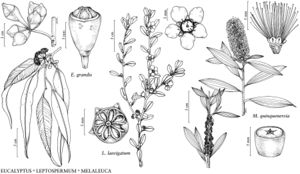Melaleuca quinquenervia
Proc. Roy. Soc. Queensland 69: 76. 1958.
Trees, 1–18 m; bark papery. Leaves alternate; blade usually narrowly elliptic to elliptic, rarely somewhat falcate, 5.5–12 × 1–3.1 cm, veins 5–7, longitudinal, surfaces glabrescent. Inflorescences 15–54-flowered, flowers in triads, pseudoterminal, sometimes also axillary distally, to 40 mm wide. Flowers: calyx lobes glabrous abaxially, margins scarious, 0.3–0.4 mm wide; petals deciduous, 2.5–3.5 mm; filaments connate in bundles of 5–10, white, cream, greenish white, green, creamy white, or creamy yellow, 10.5–20 mm, bundle claw 0.9–2.5 mm; style 11–18 mm; ovules ca. 50–65 per locule. Capsules 2.7–4 mm. Cotyledons obvolute. 2n = 22.
Phenology: Flowering year-round (commonly in fall).
Elevation: 0–30 m.
Distribution
Introduced; Fla., La., Asia (Malesia), Pacific Islands (New Caledonia), Australia, introduced also elsewhere in Pacific Islands (Hawaii), widely elsewhere.
Discussion
Melaleuca quinquenervia is a serious woody weed of wetland habitats in Florida and Louisiana. Mechanical control has not been successful and research in recent years has been focused upon biological control.
Selected References
None.
